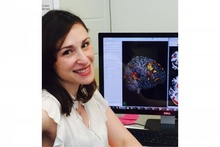Session #1 Speakers (Thursday Morning)

John Welsh, PhD
University of Washington
I am Professor of Pediatrics at the University of Washington and Principal Investigator at the Seattle Children’s Research Institute. I have been interested in the cerebellar regulation of movement, beginning at The University of Iowa where I received my Ph.D. from the Department of Psychology in 1990 under the mentorship of Professor John A. Harvey. Those early studies, performed in the Spence Laboratories, were the first to demonstrate cerebellar regulation of the timing of conditioned eyeblink responses using the rabbit classical conditioning paradigms that were emphasized there by Dr. Isidore Gormezano. I learned in vivo and in vitro cerebellar physiology under the guidance of Professor Rodolfo Llinás at NYU Medical Center. Our work during that time developed novel methods for in vivo multi-microelectrode recordings that revealed principles of distributed coding of movement control in the cerebellar climbing fiber system. My current projects are represented in two active research streams, one relating to the role electrical synaptic transmission in establishing coherent electrical oscillations in the brain and the second coming full circle to the original Iowa paradigms looking at alterations in the timing of conditioned eyeblink responses in children diagnosed with autism.

Sascha Du Lac, PhD
John Hopkins School of Medicine

Aislinn Williams, MD, PhD
The University of Iowa
The Williams lab is interested in understanding the molecular and cellular mechanisms by which genetic risk factors contribute to psychiatric disease from a developmental perspective. Our current projects focus on voltage-gated calcium channel genes, which have been linked to the risk of developing bipolar disorder, schizophrenia, depression, and autism. We use induced pluripotent stem cells and transgenic mouse models to study how calcium channel gene SNPs alter neuronal development, neural circuit function, and affective behavior. We employ a wide range of approaches, including molecular biology, live cell imaging, neuropathology, and animal behavioral assessments, to try to unravel the developmental pathways involved in neuropsychiatric disease, in the hope of identifying novel treatment targets.

John Freeman, PhD
The University of Iowa
Research in the Freeman Lab examines the neural circuitry underlying learning and memory. Our general approach is to use multiple systems neuroscience methods to identify neural circuits and neural circuit interactions necessary for learning. Our approach has shifted over the years from identifying the neural inputs and outputs necessary for learning to examining dynamic interactions among neural systems, including feedback loops and sensory gating. With this circuitry-based approach, our efforts primarily focus on three areas of learning and memory research: 1) associative motor learning, 2) categorization, and 3) the ontogeny of learning.
Session #2 Speakers (Thursday Afternoon)

Cherie Marvel, PhD
Johns Hopkins Medicine
Dr. Cherie Marvel received her PhD in Neuroscience from Georgetown University in Washington, DC in 2002. Her dissertation research examined cerebellar-related cognitive and motor deficits in schizophrenia. She completed her first post-doctoral fellowship in Clinical Neuroscience at the University of Iowa, where she furthered her training in cerebellar cognitive function in psychiatric disorders. She completed her second post-doctoral fellowship in Cognitive Neuroscience at Johns Hopkins University, where she learned to use brain imaging methods (such as functional MRI) to examine cognition.
Now an Assistant Professor of Neurology and Psychiatry & Behavioral Sciences at Johns Hopkins, Dr. Marvel’s research focuses on the interaction of cognitive and motor systems, with special emphasis on the cerebellum, in healthy and clinical populations.
Dr. Marvel's research with clinical populations includes those with cerebellar ataxia, HIV, and substance dependence. Her primary research methods include brain imaging (e.g., fMRI) and brain stimulation (e.g., Transcranial Magnetic Stimulation) and experimental cognitive paradigms to study learning, memory, and behavior.

Harry Orr, PhD
University of Minnesota

Peggy Nopoulos, MD
The University of Iowa
Dr. Nopoulos’s research focuses on the study of brain and behavior. Specifically, she studies aspects of understanding normal healthy brain such as differences in brain structure and function between the sexes as well as understanding how the brain changes with development through adolescence. In regard to the study of disease, her lab focuses on research into brain structure and function in two main areas: prematurity, and neurogenetics with focus on triplet repeat disorders (Huntington’s Disease and Myotonic Dystrophy). This is done using state of the art neuroimaging techniques, specifically Magnetic Resonance Imaging (MRI) which includes structural imaging, Diffusion Tensor Imaging, resting state fMRI, and novel sequences such as T1rho (pH imaging).

Bernd Fritzch, PhD
The University of Iowa
Dr. Fritzsch investigates the molecular development of neurosensory cells of the ear (hair cells, sensory neurons, efferents) with the aim to delay, repair and restore neurosensory hearing loss and the loss of balance. Current focus of the laboratory is on the use of neurotrophins to maintain innervation of the ear in the absence of hair cells. Recent work concentrates and the possible use of embryonic ear transplantations to investigate the molecular basis of pathfinding of afferents to enter the right nuclei in the brainstem. IN a collaborative work with the Hansen laboratory we are investigating molecular countermeasures to slow the growth of schwannoma. The laboratory uses a combination of molecular tools, transgenic animals, embryonic manipulations and pharmacological treatments in combination with various imaging techniques to analyze the outcomes of the targeted manipulations.

Aaron Boes, MD, PhD
The University of Iowa
Research in the Boes Lab is at the interface of neuroimaging and noninvasive brain stimulation. The lab uses multi-modal neuroimaging techniques to better understand brain function at a macroscopic network level, and how network dysfunction contributes to clinical symptoms, including symptoms from focal brain lesions. The ultimate goal is to use advanced neuroimaging approaches to guide treatment using noninvasive brain stimulation, including transcranial magnetic stimulation (TMS). We believe there is tremendous therapeutic potential in the combined use of advanced imaging to detect dysfunctional networks coupled with noninvasive brain stimulation to modulate these networks in a targeted way, which aligns with Dr. Boes's clinical role directing the Noninvasive Brain Stimulation Clinical Program
Session #3 Speakers (Friday Morning)

Virginia Willour, PhD
The University of Iowa
The primary goal of our laboratory is to identify genetic and epigenetic risk factors for suicidal behavior. Family, twin, and adoption studies make clear that suicidal behavior has a substantial heritable component. While there is evidence that this heritability is accounted for in part by a liability to mood disorder, other evidence suggests an independent heritable facet that may cut across multiple psychiatric disorders. In an effort to better understand the biological basis of this behavior, we have conducted a genome-wide association study (GWAS) using attempted suicide as the phenotype, an effort that identified a promising association signal on 2p25 as well as candidate genes implicating the Wnt signaling pathway and excitatory neurotransmission. These findings have prompted us to launch a large-scale whole exome sequencing project, with the goal of identifying functional variants associated with suicidal behavior on 2p25 and throughout the genome. Environmental stressors, such as child abuse and early parental loss, are also known to play important roles in triggering suicidal behavior, likely through interaction with genetic vulnerability factors. With this in mind, we have begun an epigenetics project that involves assessing genome-wide methylation patterns in post-mortem brains of suicide completers and controls, with the goal of identifying differentially methylated candidate genes and regions associated with suicidal behavior.

Steve Strakowski, MD
The University of Texas at Austin

Francis J. McMahon, MD
National Institute of Mental Health

John Wemmie, MD, PhD
The University of Iowa
Dr. Wemmie is interested in the role of brain pH and acid-sensing ion channels in brain function and behavior. This work has led to the discovery of critical roles for brain pH in synaptic plasticity, anxiety, and depression-related behaviors in mice. Current projects include investigating the synaptic mechanisms for acid-sensing ion channel action and also translating these discoveries to human behavior and brain function. For example, his laboratory is using non-invasive pH-sensitive magnetic resonance imaging to investigate the roles of brain pH in psychiatric illnesses such as panic disorder and bipolar affective disorder.
Session #4 Speakers (Friday Afternoon)

Catherine Stoodley, DPhil
American University
Catherine Stoodley is an Associate Professor in the Department of Psychology at American University and is the Director of the interdisciplinary undergraduate program in Neuroscience. Dr. Stoodley completed her doctoral training in Neuroscience at the University of Oxford with Prof. John Stein and a post-doctoral fellowship with Prof. Jeremy Schmahmann at Massachusetts General Hospital. The Stoodley Lab investigates the role of the cerebellum in typical development and developmental disorders using a variety of experimental techniques, including functional and structural imaging, transcranial direct current stimulation, and lesion-symptom mapping in patient populations.

Greta Sokoloff, PhD
The University of Iowa
Humans sleep the most when they are young and yet very little is known about why. Importantly, during infancy we spend more time in rapid eye movement (REM) sleep than at any other time in our life. Dr. Sokoloff is interested in understanding the role of sleep, especially REM sleep, in early brain development. Her work has found that the movements that accompany REM sleep, myoclonic twitches, result in strong activation of sensorimotor systems – activation that is rarely observed when infant rodents are awake. Following decades of research investigating the role of twitching on the development of the sensorimotor system in infant rodents, we are now investigating twitching in human infants. With an understanding of the quantity and patterning of twitches in early postnatal development, in concert with neural activity, we hope to leverage REM sleep twitches as an early assessment of brain and spinal cord function in typically and atypically developing human populations.

Krystal Parker, PhD
The University of Iowa
The primary goal of the Parker Lab is to characterize cerebellar neural circuitry with the goal of improving treatments for complex and devastating cognitive and mood abnormalities that are common in neuropsychiatric diseases. Our research is highly translational as we interrogate cerebellar circuitry in animals using electrophysiology, optogenetics, and pharmacology and compare these data to EEG paired with cerebellar TMS administered in clinical populations. The cerebellum contains more neurons than the rest of the brain combined and although it is most famous for its role in motor control, its contribution to cognitive and affective processes is less clear. Schizophrenia, autism, Parkinson’s disease, depression, and bipolar disorder are all examples of disorders involving cerebellar abnormalities that are characterized in part by impairments in cognition and mood. Using cerebellar modulation, we hope to capitalize on the cerebellum’s diffuse connections with the rest of the brain to identify and restore patterns of neural activity that are aberrant in disease.

Vince Magnotta, PhD
The University of Iowa
The Magnotta Lab is currently focusing on the development of quantitative magnetic resonance imaging techniques that are sensitive to brain metabolism. Currently we are focusing on T1rho, CEST, and MR spectroscopic based techniques. Using these techniques coupled with other quantitative imaging markers (e.g. T1 and T2 relaxation measures) we are exploring metabolic changes associated with several psychiatric (schizophrenia, bipolar disorder) and neurological disorders (Huntington’s disease, Alzheimer’s disease). In addition, we are exploring how metabolism changes with symptoms and disease progression. Future work will accelerate these imaging measures allowing them to assess functional changes in the brain.